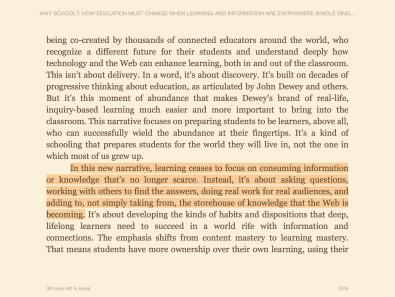In the second section of reading for the ‘Why Schools?’ reading I continued my questioning of the current system. I often found myself nodding in agreement and questioning the norm under which the majority of schools are still operating. My own school district is at a huge crossroads right, incorporating Chrome books and Google classroom throughout much of the district. Sadly, my own school has a rate of slightly less than 3 students per 1 computer (3:1). We’re hoping to receive a new shipment of Chrome books soon, giving us a 2:1 ratio. Meanwhile I’m watching how these new computers are changing how our students are interacting with technology on a daily basis. In the general education classrooms students used to have to wait until their teacher could check out the computer cart (filled with around 25 computers), now if the opportunity comes up to research or write, the students are able to quickly pick up a Chrome book and get to work. One of the teachers commented that his class is ‘significantly’ more computer literate than in previous years. All of this means big changes in how our teachers and students are able to operate on a daily basis. It also means that what and how we teach need to be flexible and ever-changing to accommodate a new style of learner that is previously unseen.I can imagine Will Richardson would be quick to agree that getting the hardware and software into students hands is critical for ‘learning reform’ to take place.
Richardson proposes an approach not based in fear, but rather collaboration and using the Internet for the valuable resource it is not a scary place to manage, edit and control our students from seeing (location 267, Richardson, 2012). The future that Richardson suggests is one that helps me feel optimistic and able to help with, and participate in more fully. Although a ‘digital immigrant’ I’m feeling fairly competent, confident, and prepared for the technological ways of collaboration that will be happening more frequently as a result of our global classroom. The screenshot below is Richardson’s comments about the collaboration and how learning needs to change. Our district upgrade to new technology is just one way digital access is rapidly changing all of our lives.
The Kindle app is accessible and I’m finding that I’m able to access it even during my busy workday at school. I’ve learned how to adjust the screen color, font size etc. which helps me read in different environments. I’m also able to leave the book I’m currently reading and go look at another book (such as a another text, or the dictionary) then return to my book in exactly the same place I’d left.
Reference:
Richardson, W. (2012). Why School? How education must change when learning and information are everywhere. TED Conferences. Kindle Edition.

Thanks for sharing Marcy! I agree with you about nodding along as you read through Richardson’s text. I too continue to find myself being frustrated with the current system and wanting to see change. While our districts are making changes, I sometimes wonder if it is fast enough or even done evenly enough. So many schools get more because of PTAs and other funding not strictly based on district funds. It will be interesting to see where time takes us.
That is great that your district is starting to provide technology for use in the classroom. It is good to hear that you are feeling capable of using the technology. I know in my school a lot of the teachers are hesitant or not able to incorporate technology due to the lack of knowledge around it.